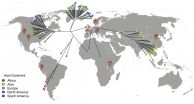(Press-News.org) TORONTO, (Aug. 13, 2015) - Low birth weight and preterm birth appear to increase the risk of schizophrenia among individuals with a genetic condition called the 22q11.2 deletion syndrome, a new study from the Centre for Addiction and Mental Health (CAMH) shows.
The research, published in Genetics in Medicine, is "...part of ongoing efforts among schizophrenia researchers to predict and prevent illness at the earliest stages possible," says senior author Dr. Anne Bassett, Clinician-Scientist in CAMH's Campbell Family Mental Health Research Institute and Canada Research Chair in Schizophrenia Genetics and Genomic Disorders.
"Low birth weight and preterm birth have been proposed as risk factors in schizophrenia in general, but past studies have not shown a large effect on risk," says Dr. Bassett, who is also the Director of the Clinical Genetics Research Program at CAMH. "We've focused our lens on these risks in a small population with a specific genetic subtype of schizophrenia, where the connection between birth factors and risk of developing schizophrenia is noticeably stronger."
The risk of schizophrenia is known to be high in individuals with 22q11.2 deletion syndrome, as about one in four develops schizophrenia. This study found the risk was even higher - nearly one in two - among those who were born with a low birth weight or prematurely, based on standard measures.
The syndrome is caused by a small deletion on chromosome 22. It can lead to heart or palate abnormalities, developmental delays and other physical health problems, and in one in four cases, a schizophrenia diagnosis in late adolescence or early adulthood.
The research, led by medical student and first author Lily Van, included 123 adults with 22q11.2 deletion syndrome. After completing genetic tests to confirm this deletion, the researchers did a comprehensive review of participants' medical records to capture details on birth weight and prematurity and through development. Psychiatrists on the study team also assessed all participants for the presence of major psychiatric illnesses, including schizophrenia.
In total, 51 patients were diagnosed with schizophrenia or schizoaffective disorder. The risk of developing schizophrenia, based on birth factors, was compared against those who did not have schizophrenia. In addition, researchers ruled out other factors, besides the genetic deletion in the baby, that could lead to prematurity or low birth weight, such as high blood pressure, gestational diabetes, smoking and substance use.
"The results needs to be replicated, but do have important clinical implications," says Dr. Bassett.
For instance, there are now prenatal tests that can signal the possibility of a 22q11.2 deletion as early as the first trimester of pregnancy. While such screening requires further confirmation through additional testing, it raises the idea of intervening, in cases where the deletion exists, during pregnancy or immediately after birth.
"The big-picture question is whether there is a way to support the developing fetal brain to improve outcomes, and lower the risk of schizophrenia," says Dr. Bassett.
INFORMATION:
The Centre for Addiction and Mental Health (CAMH) is Canada's largest mental health and addiction teaching hospital, and one of the world's leading research centres in its field. CAMH combines clinical care, research, education, policy development and health promotion to help transform the lives of people affected by mental health and addiction issues. CAMH is fully affiliated with the University of Toronto, and is a Pan American Health Organization/World Health Organization Collaborating Centre.
For more information, please visit http://www.camh.ca or follow us on Twitter @CAMHResearch
For further information:
Kate Richards, Media Relations
Centre for Addiction and Mental Health (CAMH)
416 535 8501 x36015
media@camh.ca
MANHATTAN, Kansas -- A Kansas State University biochemistry professor has reached a milestone in building a better biofuel: producing high levels of lipids with modified properties in oil seeds.
Timothy Durrett, assistant professor of biochemistry and molecular biophysics, and collaborators at Michigan State University and the University of Nebraska, Lincoln have modified Camelina sativa -- a nonfood oilseed crop -- and produced the highest levels of modified seed lipids to date. By modifying the oilseed biochemistry in camelina, the researchers have achieved very high ...
CLEMSON, S.C. -- Parishioners who participate in small groups within a religious congregation are generally more likely to be civically engaged than their fellow worshipers unless a church has high overall small-group participation, according to research recently released by Clemson and Louisiana State universities.
The study, "Small groups, contexts, and civic engagement: A multilevel analysis of United States Congregational Life Survey data," published in the July issue of the journal Social Science Research, reveals that the positive effect small-group participation ...
CORVALLIS, Ore. - A report concludes that blooms of toxic cyanobacteria, or blue-green algae, are a poorly monitored and underappreciated risk to recreational and drinking water quality in the United States, and may increasingly pose a global health threat.
Several factors are contributing to the concern. Temperatures and carbon dioxide levels have risen, many rivers have been dammed worldwide, and wastewater nutrients or agricultural fertilizers in various situations can cause problems in rivers, lakes and reservoirs.
No testing for cyanobacteria is mandated by state ...
SEATTLE, WA, AUGUST 13, 2015 - Advances in the field of statistics are helping to unlock the mysteries of the human microbiome--the vast collection of microorganisms living in and on the bodies of humans, said Katherine Pollard, a statistician and biome expert, during a session today at the 2015 Joint Statistical Meetings (JSM 2015) in Seattle.
Pollard, senior investigator at the Gladstone Institutes and professor of epidemiology and biostatistics at the University of California, San Francisco, delivered a presentation titled "Estimating Taxonomic and Functional Diversity ...
SEATTLE, WA, AUGUST 13, 2015 - The results of the first population survey of Mogadishu, Somalia, conducted in a quarter century were presented today at a session of the 2015 Joint Statistical Meetings (JSM 2015) in Seattle.
Jesse Driscoll, assistant professor of political science at the University of California, San Diego, presented the results in an invited presentation titled "Representative Surveys in Insecure Environments: A Case Study of Mogadishu, Somalia."
The representative survey, conducted in March 2012, combined the use of smartphone technology and remote-sensing ...
12.08.2015: When the western part of the super-continent Gondwana broke up around 130 Million years ago, today's Africa and South-America started to separate and the South Atlantic was born. It is commonly assumed that enormous masses of magma ascended from the deep mantle up to higher levels, and that this hot mantle plume (the Tristan mantle plume) weakened the continental lithosphere, eventually causing the break-up of the continental plate of Gondwana.
A group of German scientists are now questioning this theory. On the basis of seismic measurements published in ...
This news release is available in German.
Kalmar/Halle(Saale). Why some species of plants and animals vary more in number than others is a central issue in ecology. Now researchers at Linnaeus University in Sweden and from the Helmholtz Centre for Environmental Research (UFZ) have found an important finding to answer this question: Individual differences have a positive and stabilizing effect on the number of moths. Species with varying colour drawing are generally more numerous and fluctuate less in number from year to year. The results were recently published ...
Stillbirths have dropped by almost eight per cent in England since the smoking ban was introduced, research shows.
The number of babies dying shortly after birth has also dropped by almost eight per cent, the study estimates.
The findings add to growing evidence that anti-smoking laws have had significant benefits for infant and child health.
Researchers led by the University of Edinburgh looked at information on more than ten million births in England between 1995 and 2011.
Their findings suggest that almost 1500 stillbirths and newborn deaths were averted in ...
The team of Prof. Carsten Schmidt-Weber and Prof. Jan Gutermuth of the Center of Allergy & Environment (ZAUM) at Helmholtz Zentrum München and TU München investigated the influence of pollen extract of common ragweed, also known as Ambrosia artemisiifolia*, on B cells. These cells can produce immunoglobulin E (IgE**), the key trigger and an important diagnostic marker of allergic reactions. "We were able to show that pollen extract enhances the secretion of allergy driving IgE antibodies in vitro and in vivo", explains Dr. Sebastian Öder who is leading author ...
At home on the sofa, in a hospital bed, or in a care home: where a death takes place is always recorded on the death certificate. Until now, however, this information has never been collated and evaluated. In an Original Article in the current issue of Deutsches Ärzteblatt International (Dtsch Arztbl Int 112:496-504), Burkhard Dasch and his co-authors analyze for the first time the place of death records for Germany. What they found was that every second person died in a hospital; only one in four died at home.
The study evaluated more than 24 000 death certificates ...


